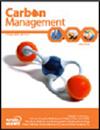缅因州北部混合物种林分实施不同森林管理处理后预计碳积累的评估
IF 3.2
4区 环境科学与生态学
Q3 ENVIRONMENTAL SCIENCES
引用次数: 2
摘要
比较在经营森林中常用的森林管理措施中森林和采伐木材产品碳(C)的储量和积累,需要为碳目标的规划和政策决策提供信息。因此,对美国缅因州北部缅因适应性造林网络的一个子集(n = 3)实施的森林管理处理中收获前和收获后的碳储量进行了量化,并对31年期间(至2050年)的碳积累进行了预测。这些设施包括成熟的次生林,由北方硬木和硬木为主的混交林组成。处理开始前,地上活树C平均存量为67.1 ~ 99.7 Mg ha−1。活树、枯木和采伐木制品的地上部分,C (AAC)的年平均净变化为0.232±1.164 Mg ha−1年−1(平均值±标准差)。预估的AAC模型表明,收获期间较少的生物量去除和较低遮荫耐受性的树种的代表性与正的AAC值相关。研究结果强调了利用多种采伐策略来实现C目标的重要性,包括考虑森林储备和使用有针对性且在操作上可行的造林处理,以提高森林对气候变化的适应能力。本文章由计算机程序翻译,如有差异,请以英文原文为准。
Evaluation of projected carbon accumulation after implementing different forest management treatments in mixed-species stands in northern Maine
Abstract Comparing forest and harvested wood product carbon (C) stocks and accumulation among forest management treatments commonly applied in managed forests is needed to inform planning and policy decisions for C objectives. Therefore, pre- and post-harvest C stocks were quantified and C accumulation was projected over a 31-year period (to ∼2050) among forest management treatments that were applied on a subset (n = 3) of the Maine Adaptive Silviculture Network installations in northern Maine, USA. These installations included mature, second-growth forests composed of northern hardwood and hardwood-dominated mixedwood stands. Before treatments were initiated, average aboveground live tree C stocks ranged from 67.1 to 99.7 Mg ha−1. For the aboveground portions of live trees, dead wood and harvested wood products, the projected average annual net change in C (AAC) was 0.232 ± 1.164 Mg ha−1 year−1 (mean ± standard deviation). Models of projected AAC indicated that less biomass removal during harvests and greater representation of tree species with low tolerance of shade were associated with positive AAC values. The results emphasize the importance of leveraging multiple harvesting strategies to achieve C objectives, including consideration of forest reserves and using targeted yet operationally feasible silvicultural treatments that promote forest resilience relative to climate change.
求助全文
通过发布文献求助,成功后即可免费获取论文全文。
去求助
来源期刊

Carbon Management
ENVIRONMENTAL SCIENCES-
CiteScore
5.80
自引率
3.20%
发文量
35
期刊介绍:
Carbon Management is a scholarly peer-reviewed forum for insights from the diverse array of disciplines that enhance our understanding of carbon dioxide and other GHG interactions – from biology, ecology, chemistry and engineering to law, policy, economics and sociology.
The core aim of Carbon Management is it to examine the options and mechanisms for mitigating the causes and impacts of climate change, which includes mechanisms for reducing emissions and enhancing the removal of GHGs from the atmosphere, as well as metrics used to measure performance of options and mechanisms resulting from international treaties, domestic policies, local regulations, environmental markets, technologies, industrial efforts and consumer choices.
One key aim of the journal is to catalyse intellectual debate in an inclusive and scientific manner on the practical work of policy implementation related to the long-term effort of managing our global GHG emissions and impacts. Decisions made in the near future will have profound impacts on the global climate and biosphere. Carbon Management delivers research findings in an accessible format to inform decisions in the fields of research, education, management and environmental policy.
 求助内容:
求助内容: 应助结果提醒方式:
应助结果提醒方式:


